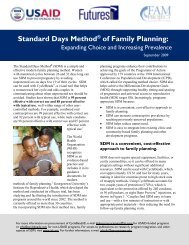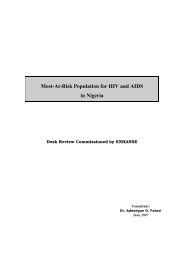Health Policy Issues and Health Programmes in ... - Amazon S3
Health Policy Issues and Health Programmes in ... - Amazon S3
Health Policy Issues and Health Programmes in ... - Amazon S3
- No tags were found...
You also want an ePaper? Increase the reach of your titles
YUMPU automatically turns print PDFs into web optimized ePapers that Google loves.
Public <strong>Health</strong> <strong>Issues</strong>, Priorities, <strong>and</strong> the Role of the GovernmentRis<strong>in</strong>g expectations for better services <strong>and</strong> the <strong>in</strong>ability of the public system to meet health careneeds have complicated the health system <strong>in</strong> India. The referral system does not work <strong>and</strong>primary health care <strong>in</strong>stitutions are bypassed, thus crowd<strong>in</strong>g higher-level health facilities. Thereis also the issue of a compet<strong>in</strong>g private sector, which poses a serious challenge. Private sectorservices are generally perceived as higher quality services <strong>and</strong> so despite its higher costs, theprivate sector seriously underm<strong>in</strong>es utilization of the public sector.The public health system operates under severe f<strong>in</strong>ancial constra<strong>in</strong>ts. The Eighth Five-Year Planmade a provision of 11,000 crore rupees for health care. However, a majority of the funds (about90%) are used for salary <strong>and</strong> related budget items, thus leav<strong>in</strong>g little for other purposes. There isa severe resource crunch <strong>and</strong> health services are starved for funds.In summary, the health systems work under severe constra<strong>in</strong>ts <strong>in</strong>clud<strong>in</strong>g the follow<strong>in</strong>g.l Inequity: Lack of access to quality basic health services by the poorllInefficiency: Inferior deployment <strong>and</strong> supervision of health functionaries <strong>and</strong> underutilization<strong>and</strong> over-crowd<strong>in</strong>g of some public health facilitiesRis<strong>in</strong>g costs: New medical technologies <strong>and</strong> ignorant clients; provider-<strong>in</strong>duced dem<strong>and</strong>for costly test procedures <strong>and</strong> treatments <strong>and</strong> cont<strong>in</strong>ued use of br<strong>and</strong>ed <strong>in</strong>stead ofgeneric drugs.InequityThere is appall<strong>in</strong>g <strong>in</strong>equity <strong>in</strong> the distribution <strong>and</strong> use of health care expenditure. Recent workhas provided astonish<strong>in</strong>g data on health expenditure. Accord<strong>in</strong>g to these studies, the poor pay19% of their <strong>in</strong>comes on health care while the rich pay only 2% of their <strong>in</strong>comes. Recentstudies report that over 80% of people use the private sector for health care; use of publicservices is marg<strong>in</strong>al. About 55% of <strong>in</strong>-patients <strong>and</strong> 80% of out-patients use the private sector. Itis further reported that household expenditures account for a major share of health careexpenses, even for the public sector.The <strong>in</strong>equity is multi-dimensional. Social <strong>in</strong>equity is evident from selected health <strong>in</strong>dicatorsfrom the various population groups, namely, those liv<strong>in</strong>g below the poverty l<strong>in</strong>e, women, <strong>and</strong>marg<strong>in</strong>alized groups (Scheduled Class/Scheduled Tribe). Not only do these people have poorhealth status (see Table 5), but they also experience low effectiveness of health services (seeTables 6 <strong>and</strong> 7).Challenges for Indian <strong>Policy</strong>-Makers <strong>and</strong> Programme ManagersDespite significant achievements dur<strong>in</strong>g the past five decades, much still needs to be done.lllA large “unf<strong>in</strong>ished agenda” of communicable diseases <strong>and</strong> maternal <strong>and</strong> nutritionaldisorders still exists <strong>in</strong> the develop<strong>in</strong>g world.There is a need to cope with age<strong>in</strong>g populations <strong>and</strong> the consequent burden of degenerativediseases <strong>and</strong> hitherto neglected <strong>in</strong>juries <strong>and</strong> accidents.There is a need to be prepared to meet emerg<strong>in</strong>g diseases, such as tobacco-related diseases<strong>and</strong> HIV/AIDS.16







